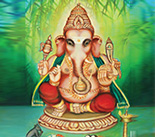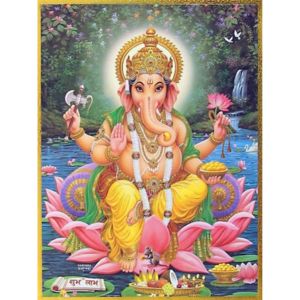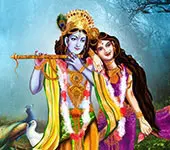This audio tells you about - 1. What are shat sampattis or six kinds of wealth in spirituality 2. How bhakti is the mother of jnana and vairagya 3. Narada Maharshi's encounter with Bhakti and her children at Vrindavan 4. How Bhagavata is the fruit of the kalpavriksha called the Vedas.
What is shat sampatti?
The shat sampattis or six assets in spirituality are- 1. Shama (शमः)- peace. 2. Dama (दमः)- self-control. 3. Uparati (उपरतिः)- renunciation of the world. 4. Titiksha (तितिक्षा) - tolerance. 5. Shraddha (श्रद्धा)- faith. 6.Samadhanam (समाधानम्) – focus on what you have to attain.
How is Bhakti the mother of Jnana and Vairagya?
In the three-fold bhakti path of Bhagavata, first comes interest in Bhagavan. Then listening to his greatness. This gives rise to limitless love for Bhagavan which is bhakti. Once bhakti comes, jnana and vairagya come naturally as if mother Bhakti has given birth to them.
What is the spiritual triangle?
Spirituality is a triangle made up of bhakti, jnana, and karma. Among these, bhakti is longer than the other two, hence more powerful and significant. However, all three sides are necessary for spirituality.
Quiz
What is Kubera's world called?Transcript
(Click here to read more)
Suta was telling the Rishis of Naimisharanya that bhakti is the essence of all shastras. Shastra means teachings. The essence of all teachings is bhakti. Then a question comes up. For obtaining moksha, jnana and vairagya are required. For jnana and vairagya, the shat-sampattis, the six assets, the six virtues are required. Only if you develop these virtues, vairagya will eventually come which will lead to jnana. Or jnana will come which will lead to vairagya. Then onl....
Transcript
(Click here)
Suta was telling the Rishis of Naimisharanya that bhakti is the essence of all shastras.
Shastra means teachings.
The essence of all teachings is bhakti.
Then a question comes up.
For obtaining moksha, jnana and vairagya are required.
For jnana and vairagya, the shat-sampattis, the six assets, the six virtues are required.
Only if you develop these virtues, vairagya will eventually come which will lead to jnana.
Or jnana will come which will lead to vairagya.
Then only moksha.
This is the prescribed path.
What are these six assets or virtues?
शमः- peace, inner peace.
दमः- control over senses.
उपरतिः- withdrawal from worldly desires and goals.
तितिक्षा- tolerance.
श्रद्धा- faith.
समाधानम्- focus on what you have to attain.
These six assets only lead to jnana and vairagya.
Where is the position of bhakti among these?
Bhakti is not part of these.
Then, will bhakti lead to jnana and vairagya and eventually moksha?
So this path of bhakti, is it different from this path?
Bhakti is the mother and jnana and vairagya are her two children.
They are toddlers.
Still fully dependent on the mother.
Wherever the mother goes, they follow.
You must have seen this.
Child holding on to the edge of mother’s saree and following her wherever she goes.
Jnana and vairagya are like children of Bhakti.
Wherever the mother is there, these children are also there.
Srimad Bhagavata narrates this mother-child relationship in a beautiful way.
Once, Narada Maharshi saw a woman on the banks of Yamuna, at Vrindavana.
She had two children with her.
Surprisingly, they were looking old and weak, very old and very weak, like those children with Progeria, premature old age.
They were very weak also.
They were so weak that they were not even able to get up.
Their mother was sitting sad.
Narada asked her who are you?
She said I am Bhakti.
And who are these?
These are my children Jnana and Vairagya.
I don’t know what has happened to them.
Look at them.
She was really concerned about them.
How can a mother be happy when her children are suffering?
कुपुत्रो जायेत क्वचिदपि कुमाता न भवति।
There can be bad progeny, but never a bad mother.
There is a typical situation here.
It is Vrindavan where Bhakti is happily settled.
There is place for only Bhakti in Vrindavana.
Nobody is bothered about Jnana and Vairagya in Vrindavana, but still, she is concerned about her children.
Had it been the children they would have walked away at such opportunity.
But she won’t.
She is a mother.
In fact, presence of Jnana and Vairagya are even detrimental to Bhakti.
ज्ञानवैराग्ययोः भक्तिप्रवेशाय उपयोगिता।
ईषत्प्रथमं एवेति नाङ्गत्वमुचितं तयोः।
Jnana and vairagya need not be a part of bhakti.
Can not be part of bhakti.
They can be of help, initially, jnana and vairagya can initially take you up to bhakti.
But, after bhakti establishes itself, they need not be even there.
Jnana and vairagya should not become hindrance to bhakti.
They should not start masking bhakti.
When you have faith that Lord Ganesha removes obstacles, that is bhakti.
But if you start searching how and you don’t get answer, the answer is there, but you don’t have access to it, you don’t have the right resources, then you start doubting.
This quest for knowledge becomes hindrance to your faith.
Earlier in the Gurukula system, they imparted knowledge systematically.
It was taken to completion.
We don’t have this today.
We are dependent on a few English books or WhatsApp messages for knowledge.
This kind of knowledge will become all the more dangerous.
It will make you lose faith, lose bhakti.
Someone says temples are nuclear energy centers.
A person with average intelligence would say, stupid!
He is only trying to spread knowledge but ends up destroying faith.
One expert will say: there is nothing called knowledge, it is only karma that gives results.
Not just like that.
He will prove.
You will be convinced.
Then the other expert will tell you: you will not gain anything by doing these mechanical things.
It is all knowledge.
He will prove.
You will be convinced.
But then, you are caught in between.
This kind of knowledge will destroy faith.
And we have a lot of these around.
Sources of such knowledge.
But some amount of knowledge is required.
Otherwise, how will you even know that Lord Krishna is there?
Not too much also.
And the person who is giving you the knowledge should have clarity as to what he is doing.
Otherwise, knowledge can be harmful.
Same with vairagya also.
If you develop aversion towards everything, then you should not end up having aversion towards God also, moksha also.
This can happen.
That is why it is said, once bhakti takes over then you need not focus on jnana and vairagya.
When they come following bhakti, then there is no problem.
Why were Jnana and Vairagya frail and weak in Vrindavana?
Because they had no takers.
The inhabitants of Vrindavana were not bothered about jnana or viragya.
Still, mother is mother.
Bhakti had concern for them.
So Narada said, let me try.
Narada Maharshi wanted to revive them, make them healthy.
Narada also became concerned.
He chanted all the Vedas along with their meanings to them.
Vedas, Upanishads; nothing happened.
He chanted Gita and explained the principles of Gita; nothing happened.
Narada went from place to place, from tirtha to tirtha, asked scholars.
How to revive Jnana and Vairagya?
Narada Maharshi, wherever he went, he found that they were all serving bhakti.
They were not even targeting moksha.
They all said, wherever bhakti is there moksha will come naturally.
We are not really bothered, when it comes, how it comes.
But here, mother Bhakti was still sad.
Narada started observing tapas.
He heard an oracle.
A voice.
You will achieve success.
Make them listen to Bhagavata, Srimad Bhagavata.
Do you know whose voice was that?
The Kumaras, Sanakadi four kumaras.
But then Narada said: but whatever is there in Bhagavata, they are principles from Veda only, Upanishads only, Gita only.
How is it going to help?
I have already made them to listen to all these.
Sugarcane is sweet.
Sugar comes from sugarcane only.
But isn’t sugar sweeter than sugarcane?
Bhagavata is the essence of all shastras and much sweeter because it is written from the point of view of bhakti.
Bhagavata is not something else.
It is निगमकल्पतरोर्गलितं फलम्।
Bhagavata is not something stand alone, a different principle, a different tatwa.
Bhagavata is the fruit of the kalpavriksha which is the Vedas.
Every scripture based on Vedas: Upanishad, Gita, Purana; they are not different from Vedas.
Bhagavata is the fruit of the kalpavriksha which is Veda.
Not for winning arguments.
Not to establish that my shastra is superior.
Bhagavata is not written for that.
There is no purva paksha, apara paksha in Bhagavata.
Bhagavata is meant straight to benefit people.
Accordingly, Narada Maharshi narrated Bhagavata to Jnana and Vairagya and they became normal.
They got back their health.
What is meant here is that bhakti is of prime importance.
If jnana and vairagya want to be more important than bhakti or equal to bhakti, then they will not survive.
They can be subservient to bhakti.
Then they can also exist, exist in a good way.
Bhakti has concern for Jnana and Vairagya also, as a mother has for her children.
Jnana and vairagya can be the means, the path to approach bhakti.
But having bhakti is most important thing.
Recommended for you
Understand the principle of Lord Ganesha through this beautiful stotra - Part 4
 Click here to know more..
Click here to know more..
Angarki Chaturthi - Significance, Legend, and Dates

When Krishna Paksha Chaturthi falls on a Tuesday, it becomes Angarki Chaturthi.....
Click here to know more..Durga Ashtakam

vande nirbaadhakarunaamarunaam sharanaavaneem. kaamapoornajakaaraadya- shreepeet'haantarnivaasineem.....
Click here to know more..
English Topics
Bhagavatam
Click on any topic to open
- 65 Bhagavan's External Deeds
- 64 Is the Body Yours?
- 63 What's So Great About The Stories Of Sri Krishna
- 62 What To Do If You Just Don't Have Interest In Bhagawan
- 61 Which God Should I Worship?
- 60 How To Observe Dharma Properly
- 59 Devotee's progress
- 58 Which Guruji Can You Trust
- 57 Bhagawan Is Beyond Human Comprehension
- 56 The Missing Piece: Why Your Spiritual Practices Are Not Working
Please wait while the audio list loads..
30
Ganapathy
Shiva
Hanuman
Devi
Vishnu Sahasranama
Mahabharatam
Practical Wisdom
Yoga Vasishta
Vedas
Rituals
Rare Topics
Devi Mahatmyam
Glory of Venkatesha
Shani Mahatmya
Story of Sri Yantra
Rudram Explained
Atharva Sheersha
Sri Suktam
Kathopanishad
Ramayana
Mystique
Mantra Shastra
Bharat Matha
Bhagavatam
Astrology
Temples
Spiritual books
Purana Stories
Festivals
Sages and Saints
